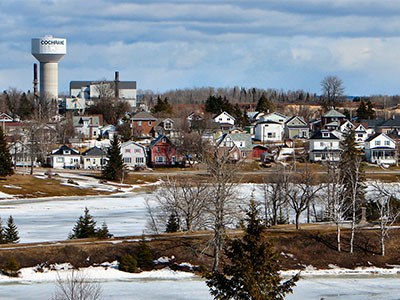In order to make an 8 a.m. flight from Timmins, Cochrane residents have to wake up four hours earlier before driving an hour up the highway in the early-morning hours, hopeful that weather is good, animals stay off the highway, and there aren't any collisions along the way.
But with a new charter air service introduced by Wabusk Air, residents can now skip that treacherous car ride in favour of flying from home in comfort.
The Moosonee-based airline has introduced twice-daily flights from Cochrane to Timmins at a cost of $110 per flight; the 30-minute flights cut down on highway travel time, giving residents and industry an alternative that, until now, has been limited to vehicular travel only.
It's been a long-standing issue that has been exacerbated in recent years by declining highway maintenance standards, making the roadways less safe for travellers, said Cochrane Mayor Peter Politis.
“The maintenance on the highways has been deteriorating year in, year out over the past half-dozen years, and they're really bad now in the wintertime,” Politis said. “So it's a safer alternative for the public, and it's a more convenient alternative for a lot of the industry that would have to fly in to Timmins and jump in a vehicle and drive into Cochrane and kill all that time in between.”
Options for airline travel have been limited since since the demise of NorOntair in the 1990s. Politis argues that, with 90 per cent of the provincial land mass in Northern Ontario, the North deserves reliable charter air service to help residents get between destinations.
The new Wabusk charter air service is not subsidized by the community in any way, but is, instead, fully supported by private industry. So far, Politis said, usage is at anticipated levels and more people are taking advantage of it as they become aware of it as an option.
Politis estimates the development will be particularly valuable to industry. For example, workers travelling to Detour Lake gold mine, located 185 kilometres north of Cochrane, formerly had to fly into Cochrane, and then travel the remaining distance by car. Workers can now get a connecting flight up to locations in the James Bay coast, including Attawapiskat, Fort Albany, and Kashechewan.
Introducing charter air service is part of a greater effort by Cochrane to develop a multi-modal transportation hub, which includes rail and a truck bypass, Politis said.
The community started development on it about three years ago, but it's now dovetailing nicely with the restructuring of Ontario Northland.
“What we're thinking is to move product by rail from the industry down south here north to Cochrane and then offload it onto trucks here, and then spread the trucks out throughout Northern Ontario,” Politis said. “So you minimize the impact on the main highway coming up, you increase the safety, you're more environmentally efficient, it's more cost-productive as well, and hopefully it'll attract more industry, too.”
When Cochrane was developed a century ago, it was envisioned as an economic hub for the North, but the need for money stalled infrastructure development.
As the Ministry of Transportation (MTO) started looking at numbers to develop Cochrane's truck bypass, it studied traffic patterns to determine if the need justified the cost associated with a potential project.
The MTO estimated there needed to be 8,000 vehicles per day to justify infrastructure investment. Numbers showed 4,000 vehicles passed through the community every 30 seconds, a number Politis calls “incredible” for a community its size.
“We know how congested it is here, but now the province knows and hopefully that will move the investment and the money and co-operation along, too,” Politis said.
Politis sees it as the start of developing Cochrane as an industrial hub for the region.
In preparation for an influx of economic development, Cochrane has been building up its infrastructure over the last three years, starting with a revision of its municipal plan. A 400-lot subdivision has been set up, with 50 lots completely serviced and ready to go. Politis said Cochrane is one of only a few communities in the North that can make that claim and is positive about its future.
“With the subdivision, and the multi-modal plan, I think we put ourselves in a very good position for any type of development down the road,” he said.




